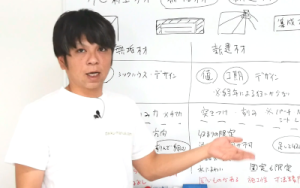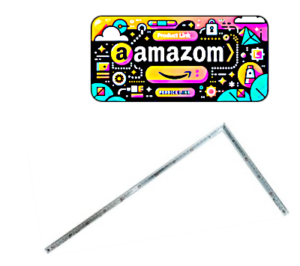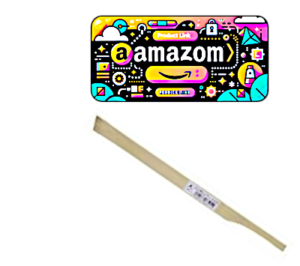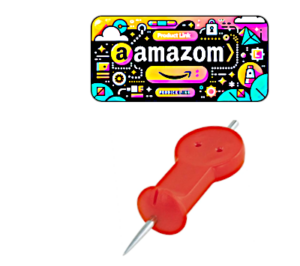This time, I’ll introduce how to use a tool called ‘Sumitsubo.’ Some might not be familiar with the term ‘Sumitsubo,’ but think of it as akin to a chalk line. Instead of chalk, ink is applied to a string, which is then stretched and snapped against wood, transferring the ink from the string to the wood to draw a straight line—consider it Japan’s ink line. The Sumitsubo has been an indispensable tool in Japanese construction since ancient times, capable of drawing lines that rulers cannot, producing lines far finer and more visible than those made with a chalk line.
It’s not a difficult tool to master, but it does require a bit of know-how to use effectively. It’s incredibly handy for woodworking and crafting, so if you’re curious, I encourage you to give it a try.
This page contains promotional content.
日本語版の記事(墨壺(すみつぼ)の使い方【プロの大工用】コツを知るだけで簡単修得!)はコチラ
List of Contents
Article Author

Kentarou Fukata
A Kyoto, Japan native born in 1985, I am a seasoned carpenter boasting five national qualifications in housing-related disciplines in Japan. Committed to the dissemination of carpentry expertise, I actively contribute to professional development within the field through instructional content on YouTube.
Introduction Video
Complementing the guide is an informative video designed to augment comprehension.
If you wish to utilize features like subtitles, please reopen the video on YouTube. You can access the subtitles through the ‘CC’ button on the playback screen or in the settings.
About ‘Sumi’ (Marking for Processing Lines)

The ‘Sumitsubo,’ also known as a ‘Sumi pot,’ is a tool used for marking ‘Sumi’ (processing lines). Understanding the role and characteristics of Sumi can be a shortcut to mastering the use of the Sumitsubo.
Main Roles of Sumi
The primary role of Sumi is to mark processing lines. Besides processing lines, it also marks baseline, directive lines, and ‘Bandzuke’ (notations of component names).
In processing work, it’s common for the person marking with Sumi to be different from the one who does the processing. It’s crucial that the processing lines are clearly understandable at a glance by the processor. Even when processing by oneself, clear and understandable marking lines improve checking efficiency and prevent mistakes.
Cleaner Sumi is Better
Buildings have long lifespans, and during renovations, the Sumi markings made by carpenters of the past often resurface. These remaining marks reveal the skill of the carpenter. Precise and clean Sumi is beautiful and pleasing to anyone who sees it. Of course, precise craftsmanship cannot be achieved without beautiful Sumi markings. Aim for clean marking, including the handling of the Sumi ink itself.
How to Use a Sumitsubo and Tips for Striking Straight
Basic Use of a Sumitsubo
The Principle of a Sumitsubo
To explain the principle of a Sumitsubo in the simplest terms, it involves pulling a string soaked in ink, pinching and flicking the inked string, so that the ink from the string is transferred onto the material.
The starting point of the string is attached to a ‘Kalko’ (a stick with a needle), which can be fixed at the starting point of the ink line. The endpoint is held down with the fingers of the hand not flicking the string. The Sumitsubo itself is equipped with a reel for winding the string, and in recent years, automatic winding types with springs have become mainstream. At the front of the reel, there’s a pot for storing ink, filled with cotton or a sponge.
Basic Striking Technique
First, fix the Kalko at the starting point of the line. At this time, wrap the string around the needle tip 2-3 times and insert it, adjusting so it doesn’t shift from the starting point. In Sumi striking, because the string is pulled strongly, insert the needle tip towards the Sumitsubo side firmly to prevent it from coming out or shifting.
On the Sumitsubo side, hold the body with the hand opposite the striking hand, pinch the string tightly so that it doesn’t get pulled out from the reel even when tension is applied, and fix the endpoint with the tip of the thumb.
※You can also fix the reel from rotating with the palm holding the body, but prioritize fixing with the fingertips.
Ink on the string dries if left untouched, so strike before it dries. Gently pinch the string with the striking hand, lift gently, and release gently.
Drawing Straight Lines on Uneven Surfaces
The Sumitsubo allows for drawing accurate straight lines even on uneven surfaces, such as log beams.
Due to the principle of the Sumitsubo, ink is applied at the intersection points between the plane passing through three points—the starting point, the ending point, and the lifted apex—and the material’s finishing surface. This principle enables the quick drawing of core lines on objects like log beams.
However, it is important to note that if the direction of the lifted apex is incorrect, an accurate line cannot be drawn. When drawing core lines, it’s crucial to adjust the position of the lifted apex so that the plane formed by the three points of string tension aligns with the plane of the core line.
Tips for Striking Sumi Straight
Use the Sumitsubo with Bare Hands
Using the Sumitsubo with bare hands is essential, as wearing gloves can lead to unintended curving. Gloves can cause the ink string to rotate when pulling or releasing it, creating a slicing effect that makes the sumi curve like a curveball.
Especially in the case of long-span sumi strikes, even a slight rotation can cause a significant curve in the sumi line. Therefore, care should be taken to release the pulled ink string without adding any rotation or twist.
Be Mindful of Wind During Outdoor Work
When using the Sumitsubo for outdoor tasks, natural wind can cause the lines to curve.
Improving Accuracy with Sectional Striking
For long-span sumi striking, where the risk of the sumi curving is higher, secure accuracy by holding down the stretched string in the middle of the span and striking in sections, front and back.
About Throwing (Bending) Sumi
While the Sumitsubo is primarily a tool for drawing straight lines, it can also create curved lines. Opportunities to need a curved sumi are rare, but understanding the principles of curving will help prevent unintentional bending when aiming for straight lines.
To bend a line, during the sumi striking process, rotate the lifted ink string with your finger (so that the upper side faces the direction of motion). When releasing, do so with the motion of ‘throwing’ the ink string in the desired direction of the curve. The released string will rotate, cutting through the air like a curveball in baseball, creating a beautiful curved sumi line.
The necessity for this technique arises from the need to adjust processing baseline considering factors like warping after processing, the weight of a roof, and fittings. This technique is challenging; it requires precision to achieve the targeted dimension in a single attempt and is not easily mastered.
Introducing Tricks Used in Skill Competitions
In Japan, there are competitions to showcase carpentry skills and skill certification exams to prove a certain level of expertise. In these events, the demand for sumi marking exceeds that of regular work, requiring it to be not only precise but also fast. Various tricks are utilized to meet these standards. These techniques, while honed in competition, are also applicable to DIY projects, so let’s take a look at some of them.
How to Make Clean Sumi Marks
When striking sumi with a Sumitsubo, excess ink can sometimes splatter around. Wiping off the excess ink from the string with a lightly squeezed rag before striking can produce sharp, pencil-like sumi lines. Regularly cleaning off the ink stains on your hands or a ‘framing square’ also prevents unnecessary mess.
Adjusting the Ink Density
In addition to the Sumitsubo, a pen called ‘Sumisashi’ is used for sumi marking tasks. The Sumisashi utilizes the ink from the Sumitsubo.
In fact, the ink concentration typically used is often too thick, and simply diluting it with water to the appropriate density can make it much more user-friendly. A good concentration guideline is to achieve a gray line, similar to the darkness of a pencil.
Diluting the ink not only reduces stains on hands and materials but also improves the ink retention on the Sumisashi, enhancing work efficiency.
Marking Multiple Short Components with Sumi
When marking the core of many components with sumi, there’s a way to reduce the number of times you need to insert and remove the Kalko, as well as the amount of sumi wiping required.
Make a notch (a groove that the string can catch on) at the core part of both ends of each component using a chisel. Then, with the Kalko stuck in the workbench, switch out the components along the string and strike the sumi.
After wiping off the excess sumi once, you can make good marks 3 to 5 times, allowing for quick and clean sumi marking.
Care Tips and Precautions for Your Sumitsubo
How to Add Water
To prevent the Sumitsubo from becoming unusable due to drying out, it’s crucial to regularly add water.
Adding water directly to the ink reservoir of the Sumitsubo can result in uneven ink adhesion and concentration, leading to poor quality marks. Instead, when adding water, ensure it is absorbed by the string in the reel section.
Precautions for Use
When using a Sumitsubo, care must be taken with the handling of the Kalko, which is equipped with a needle. If the Kalko becomes detached while the string is being pulled tightly, it can fly towards the direction it was pulled with force.
Make sure to insert the Kalko securely to prevent it from coming loose. This is especially important when working in pairs.
Choosing a Sumitsubo
Since a Sumitsubo is frequently used in professional settings, let me share some tips on choosing one with practicality in mind.
Ease of Adding Water
During summer, Sumitsubos can dry out almost daily, necessitating regular watering. For models with an automatic reel, the ease of adding water can vary significantly between manufacturers. The Tajima company’s Perfect Sumitsubo from Japan is recommended for its ease in adding water to the reel section, including detachment and spring rewinding.
About the Color of Sumi
The fundamental color of sumi is black, but for cosmetic materials (raw wood to be finished with a plane), a vermilion sumi is used as it leaves fewer stains. Additionally, there are sumi varieties specially formulated to resist smudging on damp materials, with various types available for purchase.
Regarding the Thickness of the String
The specialized string for Sumitsubo is designed to hold ink well and has a slight stretch. This characteristic is crucial, so always use the designated string for your Sumitsubo.
I recommend using a thicker string for the Sumitsubo. While a thinner string can hold more wraps, it’s prone to fraying and breaking, and it dries out faster when marking, making it less practical to use.
Size of the Sumitsubo
Recently, compact models have become available for easy transport, and there are even specialized holders sold for them.
*Personally, I don’t see the need to carry a Sumitsubo around, so I stick to using a basic, user-friendly size.
Choosing a Kalko
Kalkos come with a safety feature to prevent accidental stabbing due to the beam part being hazardous. However, while these safety-equipped Kalkos are secure, they are known for poor accuracy and are difficult to handle, thus not favored by professionals.
A smaller Kalko can be challenging to insert forcefully since it’s pinched to stab, making larger-sized Kalkos, which can be gripped and inserted more easily, recommended. Additionally, if it does come loose, a larger Kalko moves slower, reducing the risk of injury. Kalkos with hard needles designed for concrete are also advisable. The concrete type, having a blunt needle tip, requires sharpening for use on wood.
Conclusion
Have you become interested in the ‘Sumitsubo’? It’s an indispensable ink pot in Japanese carpentry. It’s not difficult to handle, so if you’re involved in carpentry, I encourage you to pick one up and give it a try. The hand-wound type can even be made by hand, so why not take on the challenge!






“Don’t know about ‘Sumitsubo’, Japan’s ink line? Let me introduce its convenient uses” への211件のフィードバック
Ace of Base — шведская поп-группа, образованная в 1990 году. Их музыкальный стиль сочетает в себе элементы поп-музыки, дэнса и электроники. Группа стала популярной благодаря хитам “All That She Wants”, “The Sign”, “Don’t Turn Around” и “Beautiful Life”. Эти композиции не только покорили чарты во многих странах мира, но и остаются классикой жанра до сих пор. Ace of Base оставили неизгладимый след в истории поп-музыки, их мелодии до сих пор радуют слушателей по всему миру. Скачать музыку 2024 года и слушать онлайн бесплатно mp3.
Не.kurili – Думай Головой (Vandalz Records) скачать в mp3 и слушать онлайн бесплатно
Не.kurili – Думай Головой (Vandalz Records)
Fkj – Ylang Ylang скачать в mp3 и слушать онлайн бесплатно
Fkj – Ylang Ylang
Музыка В Машину 2021 – Миша Марвин – Девочка, Не Бойся (Dj S7Ven Remix) скачать в mp3 и слушать онлайн бесплатно
Музыка В Машину 2021 – Миша Марвин – Девочка, Не Бойся (Dj S7Ven Remix)
Meynberg – Letting Go скачать бесплатно песню в mp3
Meynberg – Letting Go
Гурт Made In Ukraine&eurodj – (Катюша) скачать в mp3 и слушать онлайн бесплатно
Гурт Made In Ukraine&eurodj – (Катюша)
Скачать песню Sigma – Болен бесплатно в mp3
Sigma – Болен
Песня – Хит Тик Тока Цыганская (Selen Selen ) скачать песню бесплатно на телефон и слушать онлайн в mp3
Песня – Хит Тик Тока Цыганская (Selen Selen )
Frezel – Inner Turmoil скачать песню бесплатно в mp3 и слушать онлайн
Frezel – Inner Turmoil
Евгений Курский – Черноокая скачать бесплатно песню и слушать онлайн в mp3
Евгений Курский – Черноокая
Скриптонит – Скриптонит – Я Не Улыбаюсь (Redline Remix) скачать песню в mp3 и слушать онлайн бесплатно
Скриптонит – Скриптонит – Я Не Улыбаюсь (Redline Remix)
Витас – Уа скачать бесплатно песню в mp3
Витас – Уа
Скачать песню Duncan Gray – Forge бесплатно в mp3
Duncan Gray – Forge
Михайло Хома – З Днем Народження – Вариант 3 скачать песню бесплатно на телефон и слушать онлайн в mp3
Михайло Хома – З Днем Народження – Вариант 3
Вячеслав Добрынин И Маша Распутина – Льётся Музыка скачать песню бесплатно в mp3 и слушать онлайн
Вячеслав Добрынин И Маша Распутина – Льётся Музыка
Юля Чернова – Возьми На Время Мою Боль скачать бесплатно песню и слушать онлайн в mp3
Юля Чернова – Возьми На Время Мою Боль
Воллны – День Мертвых скачать бесплатно песню в mp3
Воллны – День Мертвых
Palisades – Erase The Pain скачать песню в mp3 и слушать онлайн бесплатно
Palisades – Erase The Pain
Скачать песню Viscera Drip – Antichrist бесплатно в mp3
Viscera Drip – Antichrist
Украинские Хиты – Віа КіпЯток – Корпоратив скачать песню бесплатно на телефон и слушать онлайн в mp3
Украинские Хиты – Віа КіпЯток – Корпоратив
Qarakesek – Суйикти Етши _ Cover скачать песню бесплатно в mp3 и слушать онлайн
Qarakesek – Суйикти Етши _ Cover
Богдан Тихончик – Моя Мила скачать бесплатно песню и слушать онлайн в mp3
Богдан Тихончик – Моя Мила
Kozak System – Хто Як Не Ти скачать бесплатно песню в mp3
Kozak System – Хто Як Не Ти
Скачать песню Мегаполис – Снег Идёт бесплатно в mp3
Мегаполис – Снег Идёт
Ганвест – Дурман скачать песню в mp3 и слушать онлайн бесплатно
Ганвест – Дурман
Ілля Найда – Жаль, Не Знала Вона скачать песню бесплатно на телефон и слушать онлайн в mp3
Ілля Найда – Жаль, Не Знала Вона
Саша Рычкова – Письмо Из Лета скачать песню бесплатно в mp3 и слушать онлайн
Саша Рычкова – Письмо Из Лета
Clean Bandit Feat. Marina & Luis Fonsi – Baby (Acoustic) скачать бесплатно песню и слушать онлайн в mp3
Clean Bandit Feat. Marina & Luis Fonsi – Baby (Acoustic)
Аркадий Кобяков – Уйду На Рассвете (Remix) скачать бесплатно песню в mp3
Аркадий Кобяков – Уйду На Рассвете (Remix)
Slame Feat. Cherocky – Deep Love скачать песню в mp3 и слушать онлайн бесплатно
Slame Feat. Cherocky – Deep Love
Скачать песню Парень Из Союза – Кайфуй Москва New Version (Dj Tebriz) бесплатно в mp3
Парень Из Союза – Кайфуй Москва New Version (Dj Tebriz)
Stromae – Я На Работу Пиздую скачать песню бесплатно на телефон и слушать онлайн в mp3
Stromae – Я На Работу Пиздую
Metallica – Пыяла (Cover) скачать песню бесплатно в mp3 и слушать онлайн
Metallica – Пыяла (Cover)
Almklausi – Party (Everybody) (Party Mix) скачать бесплатно песню и слушать онлайн в mp3
Almklausi – Party (Everybody) (Party Mix)
Антиреспект – Там скачать песню в mp3 и слушать онлайн бесплатно
Антиреспект – Там
Jah Khalib – Бестия скачать бесплатно песню в mp3
Jah Khalib – Бестия
Скачать песню Ассорти – Выстрел бесплатно в mp3
Ассорти – Выстрел
Черепаха-Аха-Аха. – Черепаха-Аха-Аха. скачать песню бесплатно на телефон и слушать онлайн в mp3
Черепаха-Аха-Аха. – Черепаха-Аха-Аха.
Shaman – Встанем (10 Element Deep Remix) скачать песню бесплатно в mp3 и слушать онлайн
Shaman – Встанем (10 Element Deep Remix)
Александр Серов – Запомни скачать бесплатно песню и слушать онлайн в mp3
Александр Серов – Запомни
Dr. Alban – Away From Home (Dj.polattt Remix) скачать бесплатно песню и слушать онлайн в mp3
Dr. Alban – Away From Home (Dj.polattt Remix)
Drake – Hotline Bling Hotline Bling скачать в mp3 и слушать онлайн бесплатно
Drake – Hotline Bling Hotline Bling
Lil Peep – Falling Down скачать песню в mp3 и слушать онлайн бесплатно
Lil Peep – Falling Down
Bawn & Sudno – Місто Розбитих Надій скачать песню бесплатно в mp3 и слушать онлайн
Bawn & Sudno – Місто Розбитих Надій
Luis Fonsi – Sola скачать бесплатно песню и слушать онлайн в mp3
Luis Fonsi – Sola
Omar Souleyman – Layle (Boys Noize Remix) скачать песню бесплатно в mp3 и слушать онлайн
Omar Souleyman – Layle (Boys Noize Remix)
Скачать песню Dimitris Athanasiou – A Beautiful Girl бесплатно в mp3
Dimitris Athanasiou – A Beautiful Girl
Віталій Лобач І Ю.шмегельський – Оля, Чом Же Ми Не Двоє (Video) скачать песню бесплатно на телефон и слушать онлайн в mp3
Віталій Лобач І Ю.шмегельський – Оля, Чом Же Ми Не Двоє (Video)
Алина Делисс – Поезда скачать в mp3 и слушать онлайн бесплатно
Алина Делисс – Поезда
Zarina Tilidze – Habibi (Mon El Remix) скачать песню в mp3 и слушать онлайн бесплатно
Zarina Tilidze – Habibi (Mon El Remix)
Miyagi & Эндшпиль – I Got Love – 30 Песен На 1 Бит – Mashup By Nila Mania & Mr. Simon (Чёрный Перец) скачать бесплатно песню в mp3
Miyagi & Эндшпиль – I Got Love – 30 Песен На 1 Бит – Mashup By Nila Mania & Mr. Simon (Чёрный Перец)
Begench Charyyew (Bego) – Saherin Gyzlary скачать бесплатно песню и слушать онлайн в mp3
Begench Charyyew (Bego) – Saherin Gyzlary
Vavan – Тяп Ляп (Anton Ishutin Remix) скачать песню бесплатно в mp3 и слушать онлайн
Vavan – Тяп Ляп (Anton Ishutin Remix)
Українські Народні Пісні Гуцулка Ксеня – Гуцулка Ксеня скачать песню бесплатно на телефон и слушать онлайн в mp3
Українські Народні Пісні Гуцулка Ксеня – Гуцулка Ксеня
Скачать песню Александр Эгромжан – Держи Меня Земля бесплатно в mp3
Александр Эгромжан – Держи Меня Земля
Шугар – Туман (Fatan Remix) скачать в mp3 и слушать онлайн бесплатно
Шугар – Туман (Fatan Remix)
Хиты 2018 – Hammali & Navai – Задыхаюсь скачать песню в mp3 и слушать онлайн бесплатно
Хиты 2018 – Hammali & Navai – Задыхаюсь
Коррупция – Прокурорша скачать бесплатно песню в mp3
Коррупция – Прокурорша
Туркменская Музыка – Palwan Halmyradow – Owgan Rowayaty ( Туркменская Армейская Под Гитару ) скачать бесплатно песню и слушать онлайн в mp3
Туркменская Музыка – Palwan Halmyradow – Owgan Rowayaty ( Туркменская Армейская Под Гитару )
Hlz – The Morning After скачать песню бесплатно в mp3 и слушать онлайн
Hlz – The Morning After
Степан Гіга – Золото Карпат скачать песню бесплатно на телефон и слушать онлайн в mp3
Степан Гіга – Золото Карпат
Скачать песню Калвин Харрис/sam Smith – Desire бесплатно в mp3
Калвин Харрис/sam Smith – Desire
Цветочек – Куда Несет Дым скачать песню в mp3 и слушать онлайн бесплатно
Цветочек – Куда Несет Дым
Nila Mania – Давай Подэнсим скачать бесплатно песню в mp3
Nila Mania – Давай Подэнсим
Las Vegas – Не Хадзіце, Мае Хлопчыкі (Минус) Sk скачать в mp3 и слушать онлайн бесплатно
Las Vegas – Не Хадзіце, Мае Хлопчыкі (Минус) Sk
Dario Caruson – Dromo скачать бесплатно песню и слушать онлайн в mp3
Dario Caruson – Dromo
Jemmy – Обмани Меня скачать песню бесплатно в mp3 и слушать онлайн
Jemmy – Обмани Меня
Скачать песню Мари Краймбрери – My Май бесплатно в mp3
Мари Краймбрери – My Май
Українські Весільні Пісні – Гоп Ца-Ца скачать песню бесплатно на телефон и слушать онлайн в mp3
Українські Весільні Пісні – Гоп Ца-Ца
Музыка Из Тик Ток (Тик-Тока) – White Gallows – В Лифте скачать песню в mp3 и слушать онлайн бесплатно
Музыка Из Тик Ток (Тик-Тока) – White Gallows – В Лифте
Gayazov Brother – Пьяный Туман (Treemaine Remix) скачать в mp3 и слушать онлайн бесплатно
Gayazov Brother – Пьяный Туман (Treemaine Remix)
Сестри Басараби – Тату, Татусю скачать бесплатно песню в mp3
Сестри Басараби – Тату, Татусю
Kanu Chris Bowl – Stomp Your Feet (Extended Mix) скачать бесплатно песню и слушать онлайн в mp3
Kanu Chris Bowl – Stomp Your Feet (Extended Mix)
Ayur Tsyrenov Feat. Антон Балков – Отшумели Летние Дожди скачать песню бесплатно в mp3 и слушать онлайн
Ayur Tsyrenov Feat. Антон Балков – Отшумели Летние Дожди
Скачать песню Marina (Марина Алексеева) & Renato Monti – Между Небом И Морем бесплатно в mp3
Marina (Марина Алексеева) & Renato Monti – Между Небом И Морем
Музыка В Машину 2023 – Rnbstylerz – Like Wooh Wooh (Radio Edit) скачать песню бесплатно на телефон и слушать онлайн в mp3
Музыка В Машину 2023 – Rnbstylerz – Like Wooh Wooh (Radio Edit)
Miyagi Feat. Andy Panda – Говори Мне скачать песню в mp3 и слушать онлайн бесплатно
Miyagi Feat. Andy Panda – Говори Мне
Niman Feat. Truwer, Скриптонит – Талия (Remix) скачать бесплатно песню в mp3
Niman Feat. Truwer, Скриптонит – Талия (Remix)
Ілля Найда – Симпатюлька скачать в mp3 и слушать онлайн бесплатно
Ілля Найда – Симпатюлька
Kvpv – Problems (Original Mix) скачать бесплатно песню и слушать онлайн в mp3
Kvpv – Problems (Original Mix)
Оркестр Поля Мориа – Поль Мориа – Тема Любви скачать песню бесплатно в mp3 и слушать онлайн
Оркестр Поля Мориа – Поль Мориа – Тема Любви
Скачать песню Глупое Солнце – Давай Вали бесплатно в mp3
Глупое Солнце – Давай Вали
Музыка В Машину 2024 – Miley Cyrus – Flowers 2023 (Dr.luxe & Dj Finn Remix) (Radio Edit) скачать песню бесплатно на телефон и слушать онлайн в mp3
Музыка В Машину 2024 – Miley Cyrus – Flowers 2023 (Dr.luxe & Dj Finn Remix) (Radio Edit)
Найда Ілля – А Ти Була скачать бесплатно песню в mp3
Найда Ілля – А Ти Була
Dj Smash, Клава Кока – Пятница (SmashS Club Remix) скачать песню в mp3 и слушать онлайн бесплатно
Dj Smash, Клава Кока – Пятница (SmashS Club Remix)
Lil West – Fukk Codered (Ft. Night Lovell) скачать в mp3 и слушать онлайн бесплатно
Lil West – Fukk Codered (Ft. Night Lovell)
Ella Mai Ft Chris Brown – Whatchamacallit (Bpm Supreme Redrum) (Dirty) скачать бесплатно песню и слушать онлайн в mp3
Ella Mai Ft Chris Brown – Whatchamacallit (Bpm Supreme Redrum) (Dirty)
Sides & Mkly – Mauro (Extended Mix) скачать песню бесплатно в mp3 и слушать онлайн
Sides & Mkly – Mauro (Extended Mix)
Скачать песню T-Killah, Matara – Люби Меня Люби бесплатно в mp3
T-Killah, Matara – Люби Меня Люби
Музыка В Машину 2024 – Modern Talking – YouRe My Heart, YouRe My Soul (Tina Walen Remix) скачать песню бесплатно на телефон и слушать онлайн в mp3
Музыка В Машину 2024 – Modern Talking – YouRe My Heart, YouRe My Soul (Tina Walen Remix)
Kozak System – Така Спокуслива скачать бесплатно песню в mp3
Kozak System – Така Спокуслива
Артур Пирожков – Как Челентано скачать в mp3 и слушать онлайн бесплатно
Артур Пирожков – Как Челентано
Hammali & Navai – Ты Позвонишь Ночью скачать песню в mp3 и слушать онлайн бесплатно
Hammali & Navai – Ты Позвонишь Ночью
Innanet James – Amazing скачать бесплатно песню и слушать онлайн в mp3
Innanet James – Amazing
Armin Van Buuren Feat. Dangello & Francis – Que Pasa скачать песню бесплатно в mp3 и слушать онлайн
Armin Van Buuren Feat. Dangello & Francis – Que Pasa
Украинские Хиты – Shumei – Вище Хмар скачать песню бесплатно на телефон и слушать онлайн в mp3
Украинские Хиты – Shumei – Вище Хмар
Скачать песню Юлианна Караулова – Просто Так бесплатно в mp3, текст песни, смотреть клип
Юлианна Караулова – Просто Так
Teksidr – Плохие Привычки скачать бесплатно песню в mp3
Teksidr – Плохие Привычки
Anivar D&m – Украду (Remix) скачать в mp3 и слушать онлайн бесплатно
Anivar D&m – Украду (Remix)
Farhat – Унеси Меня Ветер скачать бесплатно песню и слушать онлайн в mp3
Farhat – Унеси Меня Ветер
Би-2 – Большие Города скачать песню бесплатно в mp3 и слушать онлайн
Би-2 – Большие Города
Скачать песню Йорш – Девочка В Сине-Зелёном Платье бесплатно в mp3
Йорш – Девочка В Сине-Зелёном Платье
Украинские Хиты – Сергей Бабкин – Де Би Я скачать песню бесплатно на телефон и слушать онлайн в mp3
Украинские Хиты – Сергей Бабкин – Де Би Я
Гимн Казантипа 2006 – Гимн Казантипа 2006 скачать песню в mp3 и слушать онлайн бесплатно
Гимн Казантипа 2006 – Гимн Казантипа 2006
Ілля Найда – Я Кохаю скачать бесплатно песню в mp3
Ілля Найда – Я Кохаю
Софія Верига – Українська Господиня скачать бесплатно песню и слушать онлайн в mp3
Софія Верига – Українська Господиня
Ponch Feat. Vnas – Izabel (Sadins1De Remix) скачать в mp3 и слушать онлайн бесплатно
Ponch Feat. Vnas – Izabel (Sadins1De Remix)
Dzeko, Keith Urban – Both Still Young скачать песню бесплатно в mp3 и слушать онлайн
Dzeko, Keith Urban – Both Still Young
Скачать песню Avy – Ну Кто Сказал бесплатно в mp3
Avy – Ну Кто Сказал
Музыка В Машину 2023 – Robert Cristian Feat. Dayana – The Sweetest Ass In The World скачать песню бесплатно на телефон и слушать онлайн в mp3
Музыка В Машину 2023 – Robert Cristian Feat. Dayana – The Sweetest Ass In The World
Максим Свобода – Ф скачать песню в mp3 и слушать онлайн бесплатно
Максим Свобода – Ф
Teksidr – Плохие Привычки скачать бесплатно песню в mp3
Teksidr – Плохие Привычки
Александр Певчий – Вдова скачать бесплатно песню и слушать онлайн в mp3
Александр Певчий – Вдова
Танцевальная Русская Музыка – Женщина, Я Не Танцую скачать в mp3 и слушать онлайн бесплатно
Танцевальная Русская Музыка – Женщина, Я Не Танцую
Адилет Жаугашар – Мамау скачать песню бесплатно в mp3 и слушать онлайн
Адилет Жаугашар – Мамау
Скачать песню Сергій Делечук – Не Скажеш Ні, Не Скажеш Так бесплатно в mp3
Сергій Делечук – Не Скажеш Ні, Не Скажеш Так
Украинские Хиты – Volkanov – Сумую скачать песню бесплатно на телефон и слушать онлайн в mp3
Украинские Хиты – Volkanov – Сумую
Ілля Найда – Я Так Люблю скачать бесплатно песню в mp3
Ілля Найда – Я Так Люблю
Tj_Beastboy – 1000X Cooler скачать в mp3 и слушать онлайн бесплатно
Tj_Beastboy – 1000X Cooler
Hammali & Navai – Хочешь, Я К Тебе Приеду Хочешь, Я К Тебе Приеду скачать песню в mp3 и слушать онлайн бесплатно
Hammali & Navai – Хочешь, Я К Тебе Приеду Хочешь, Я К Тебе Приеду
Последние новинки музыки 2024 скачать и слушать онлайн бесплатно
Музыка 2024 – слушать онлайн и скачать бесплатно без регистрации в хорошем качестве mp3
Популярные песни 2024 скачать mp3 и слушать онлайн
На данном сайте вы можете скачать новинки музыки бесплатно в mp3, самые свежие новинки 2024.
На данном сайте вы можете скачать и слушать новинки музыки 2024 года бесплатно в хорошем качестве.
На нашем сайте вы можете скачать музыку 2024 года бесплатно в mp3 формате.
Последние новинки музыки 2024 скачать и слушать онлайн
Музыка 2024 – слушать онлайн и скачать бесплатно без регистрации в хорошем качестве mp3
Популярные песни 2024 скачать mp3 и слушать онлайн
На данном сайте вы можете скачать новинки музыки бесплатно в mp3, самые свежие новинки 2024.
Скачать и слушать новинки музыки бесплатно
На нашем сайте вы можете скачать музыку 2024 года бесплатно в mp3 формате.
Последние новинки музыки 2024 скачать и слушать онлайн бесплатно
Популярные песни 2024 года, скачать mp3 и слушать онлайн бесплатно
Музыка 2024 года слушать онлайн и скачать бесплатно mp3
Скачать новинки музыки 2024 самые последние хиты
Скачать и слушать новинки музыки бесплатно
На нашем сайте вы можете скачать музыку 2024 года бесплатно в mp3 формате.
Последние новинки музыки 2024 скачать и слушать онлайн бесплатно
Популярные песни 2024 скачать mp3 и слушать онлайн
Музыка 2024 – слушать онлайн и скачать бесплатно без регистрации в хорошем качестве mp3
Скачать новинки музыки 2024 самые последние хиты
Скачать и слушать новинки музыки 2024 бесплатно в хорошем качестве
Скачать музыку бесплатно в mp3
На нашем сайте вы можете скачать и слушать онлайн последние новинки музыки 2024 бесплатно.
Музыка 2024 – слушать онлайн и скачать бесплатно без регистрации в хорошем качестве mp3
Популярные песни 2024 скачать mp3 и слушать онлайн
Скачать новинки музыки 2024 бесплатно в mp3, самые свежие новинки
На нашем сайте вы можете скачать музыку 2024 года бесплатно в mp3 формате.
Скачать и слушать новинки музыки бесплатно
Последние новинки музыки 2024 скачать и слушать онлайн бесплатно
На данном сайте вы можете скачать в mp3 качестве и слушать онлайн популярные песни 2024 года, сайт обновляется новыми хитами каждый день.
На данном сайте вы можете слушать онлайн и скачать музыку 2024 года бесплатно без регистрации в хорошем качестве mp3.
Скачать новинки музыки 2024 бесплатно в mp3, самые свежие новинки
Скачать и слушать новинки музыки 2024 бесплатно в хорошем качестве
Скачать музыку 2024 года бесплатно в mp3
На нашем сайте вы можете скачать и слушать онлайн последние новинки музыки 2024 бесплатно.
Музыка 2024 – слушать онлайн и скачать бесплатно без регистрации в хорошем качестве mp3
На данном сайте вы можете скачать в mp3 качестве и слушать онлайн популярные песни 2024 года, сайт обновляется новыми хитами каждый день.
На данном сайте вы можете скачать новинки музыки бесплатно в mp3, самые свежие новинки 2024.
На данном сайте вы можете скачать и слушать новинки музыки 2024 года бесплатно в хорошем качестве.
Скачать музыку 2024 года бесплатно в mp3
На нашем сайте вы можете скачать и слушать онлайн последние новинки музыки 2024 бесплатно.
Популярные песни 2024 скачать mp3 и слушать онлайн
Музыка 2024 года слушать онлайн и скачать бесплатно mp3
Скачать новинки музыки 2024 самые последние хиты
На нашем сайте вы можете скачать музыку 2024 года бесплатно в mp3 формате.
Скачать и слушать новинки музыки бесплатно
На нашем сайте вы можете скачать и слушать онлайн последние новинки музыки 2024 бесплатно.
Популярные песни 2024 скачать mp3 и слушать онлайн
Музыка 2024 года слушать онлайн и скачать бесплатно mp3
На данном сайте вы можете скачать новинки музыки бесплатно в mp3, самые свежие новинки 2024.
Скачать и слушать новинки музыки бесплатно
На нашем сайте вы можете скачать музыку 2024 года бесплатно в mp3 формате.
Последние новинки музыки 2024 скачать и слушать онлайн
Музыка 2024 – слушать онлайн и скачать бесплатно без регистрации в хорошем качестве mp3
Популярные песни 2024 года, скачать mp3 и слушать онлайн бесплатно
Скачать новинки музыки 2024 бесплатно в mp3, самые свежие новинки
Скачать музыку бесплатно в mp3
На данном сайте вы можете скачать и слушать новинки музыки 2024 года бесплатно в хорошем качестве.
На нашем сайте вы можете скачать и слушать онлайн последние новинки музыки 2024 бесплатно.
Популярные песни 2024 скачать mp3 и слушать онлайн
На данном сайте вы можете слушать онлайн и скачать музыку 2024 года бесплатно без регистрации в хорошем качестве mp3.
На данном сайте вы можете скачать новинки музыки бесплатно в mp3, самые свежие новинки 2024.
Скачать и слушать новинки музыки 2024 бесплатно в хорошем качестве
На нашем сайте вы можете скачать музыку 2024 года бесплатно в mp3 формате.
Iniko – Jericho скачать бесплатно песню и слушать онлайн в mp3
Iniko – Jericho
Miyagi (Мияги) & Эндшпиль – Тамада скачать песню бесплатно на телефон и слушать онлайн в mp3
Miyagi (Мияги) & Эндшпиль – Тамада
Скачать песню Kosmirak – Твої Вуста бесплатно в mp3
Kosmirak – Твої Вуста
Nothing But Thieves – There Was Sun скачать песню бесплатно в mp3 и слушать онлайн
Nothing But Thieves – There Was Sun
Туркменская Музыка – Неизвестно – Любите По Туркменски скачать в mp3 и слушать онлайн бесплатно
Туркменская Музыка – Неизвестно – Любите По Туркменски
Eldzhey & Feduk – Розовое Вино (Dj Ramirez & Mike Temoff Remix) скачать бесплатно песню в mp3
Eldzhey & Feduk – Розовое Вино (Dj Ramirez & Mike Temoff Remix)
The Isley Brothers – Mercy Mercy Me скачать песню в mp3 и слушать онлайн бесплатно
The Isley Brothers – Mercy Mercy Me
Kazim Can – Omrum 2019 (Dj Tebriz) скачать бесплатно песню и слушать онлайн в mp3
Kazim Can – Omrum 2019 (Dj Tebriz)
Хиты 2023 – Гио Пика – Листопадом скачать песню бесплатно на телефон и слушать онлайн в mp3
Хиты 2023 – Гио Пика – Листопадом
Макс Вертиго & jaroom & юлия Королева – Я Вернусь скачать песню бесплатно в mp3 и слушать онлайн
Макс Вертиго & jaroom & юлия Королева – Я Вернусь
Анна Плетнва – Интуиция скачать бесплатно песню в mp3
Анна Плетнва – Интуиция
Onerepublic – Counting Stars скачать в mp3 и слушать онлайн бесплатно
Onerepublic – Counting Stars
Грибы – Тает Лёд скачать песню в mp3 и слушать онлайн бесплатно
Грибы – Тает Лёд
Dj Tyga (Mix)…. – Traag + Blackout (Remix 2018)… скачать бесплатно песню и слушать онлайн в mp3
Dj Tyga (Mix)…. – Traag + Blackout (Remix 2018)…
Newman – Moving Target скачать песню бесплатно в mp3 и слушать онлайн
Newman – Moving Target
Voytya – Відлітаю скачать песню бесплатно на телефон и слушать онлайн в mp3
Voytya – Відлітаю
Скачать песню Xravial – Хейт бесплатно в mp3
Xravial – Хейт
Игорь Крутой & lara Fabian – Les Feuilles Mortes скачать в mp3 и слушать онлайн бесплатно
Игорь Крутой & lara Fabian – Les Feuilles Mortes
Виа Волга-Волга – Ира 2 скачать бесплатно песню в mp3
Виа Волга-Волга – Ира 2
Ben Harper – Found The One скачать песню в mp3 и слушать онлайн бесплатно
Ben Harper – Found The One
Face – Подруга Подруг скачать бесплатно песню и слушать онлайн в mp3
Face – Подруга Подруг
Музыка В Машину 2020 – Мэвл – Холодок (Rakurs & Artem Shustov Extended Remix) скачать песню бесплатно в mp3 и слушать онлайн
Музыка В Машину 2020 – Мэвл – Холодок (Rakurs & Artem Shustov Extended Remix)
Скачать песню Тнмк – Проiхали бесплатно в mp3, текст песни, смотреть клип
Тнмк – Проiхали, текст песни, смотреть клип
Українські Народні Пісні – Я Люблю Так Тебе, Не Любиш Ти Мене… скачать песню бесплатно на телефон и слушать онлайн в mp3
Українські Народні Пісні – Я Люблю Так Тебе, Не Любиш Ти Мене…
The Lumineers – Life In The City скачать в mp3 и слушать онлайн бесплатно
The Lumineers – Life In The City